
 |
|
|
#1 |
|
Watch out for your cornhole !
 Join Date: Jun 2003
Location: Azle, Texas
Posts: 14,162
|
Cooling System 101
Lately, there has been a rash of questions concerning cooling systems and overheating, so I decided to write down my thoughts on cooling systems. There always seem to be misconceptions concerning this issue. I feel that with a sound basis in theory, there is no need for these misconceptions. I always found that the mechanics that I worked with who struggled with these issues usually didnít take the time to learn sound theory base to help them troubleshoot and repair overheating and other cooling system problems.
First, I want to discuss the components of a typical cooling system: Radiator- The radiator could also be called a heat exchanger. Itís purpose is to remove the heat from the hot engine coolant and transfer it to the air passing through the radiator. There are two configurations of radiators, vertical flow and cross flow. In Chevy trucks, pre 67 used vertical flow and post 67 used cross flow. What this means is that the tanks are either on top and bottom (vertical) or left and right sides (cross flow) of the radiator. That is, the coolant either drains through the core from top to bottom or left to right. Crossflow radiator 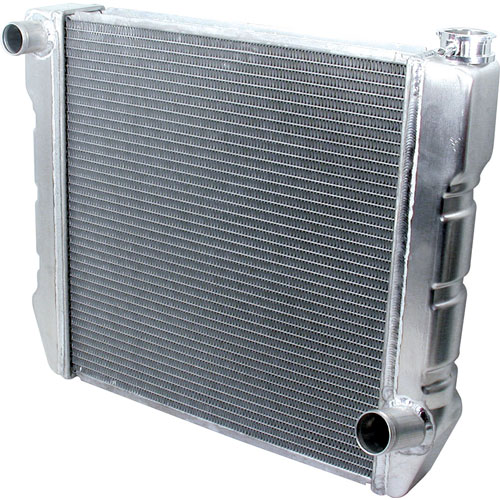 Downflow radiator 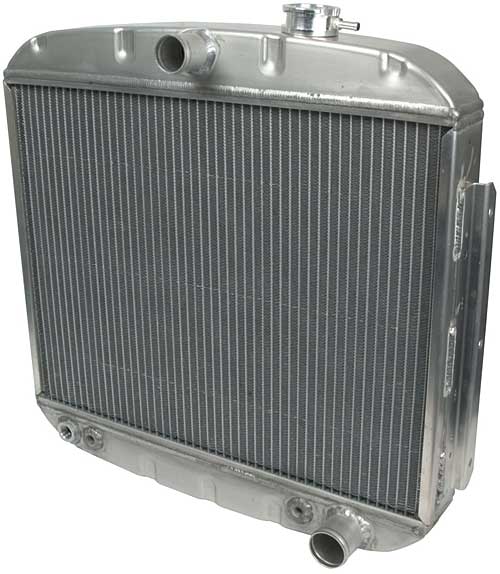 In theory, the crossflow is superior because it allows the radiator cap to be located on the suction side of the radiator rather than the pressure side. This keeps the cap from being subjected to pressure from incoming water from the thermostat. The radiator will have two radiator hose bungs on it, one mounted near the top and the other mounted near the bottom. The radiator may or may not have another bung on it for a heater hose, depending on the original routing of the hoses in the truck (more on this later). There will be a drain petcock near the bottom too, to allow coolant to be removed for servicing. Heater Core- 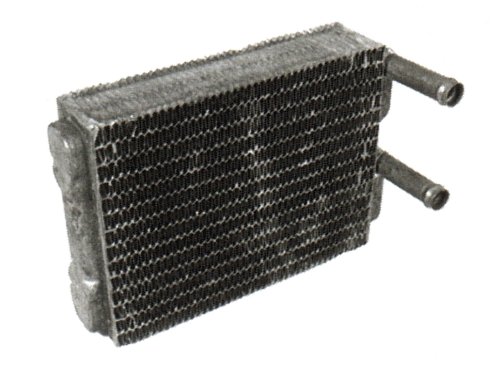 The heater core is simply another heat exchanger mounted so that a fan blows air over it to remove heat, quite similar to the radiator we discussed above. The heater core is much smaller. This heated air is then ducted out of the heater case and used to warm the interior of the truck. Thermostat- 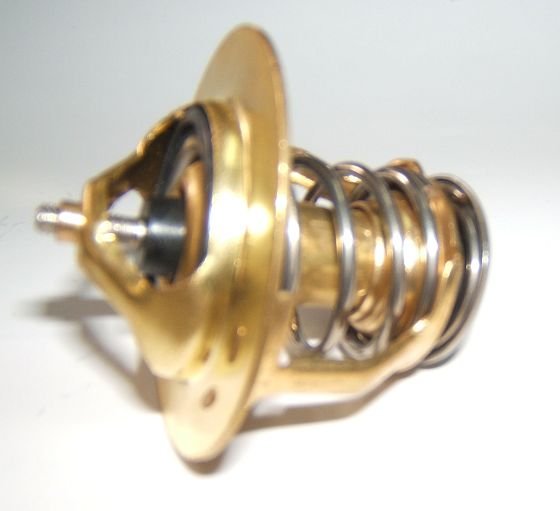 The thermostat is the most misunderstood component of the system. Simply put, its job in life is to control the flow of coolant through the cooling system in an attempt to regulate it to the proper temperature (again, much more on this later). Water Pump- 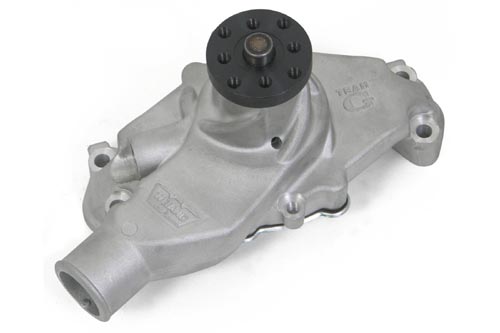 The water pump is mounted to the engine block and is driven by an accessory belt off of the crankshaft. It is known as a centrifugal design pump. Itís job is to move the water throughout the system when the thermostat needs it to. All GM trucks 1972 and earlier used a short water pump originally.This is true both of big and small block engines. This places the alternator on the driver's side of the engine. If you have a passenger side mounted alternator, your truck probably has been converted to long water pump sometime in it's past. Belts and Hoses- 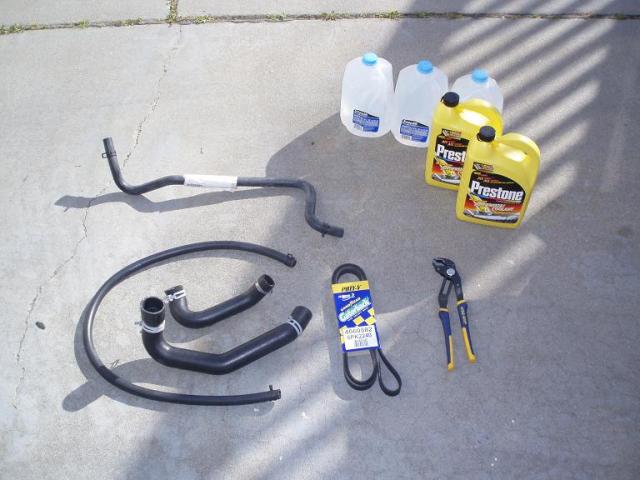 The belt drives the water pump through pulleys. The hoses connect different parts of the cooling system. There are two different sizes of heater hoses, 5/8 inch and ĺ inch. The hoses allow relative movement between two components too. The engine tends to move around a bit under operation and the hoses being flexible allow the radiator to be mounted firmly and the engine to wiggle without transferring the movement to the radiator like hard lines would. Coolant-  Is typically a 50/50 mixture of ethylene glycol and water. This 1:1 ratio is considered the ideal compromise in cooling efficiency and corrosion protection. Straight water is a better coolant, but the antifreeze lends corrosion protection so your cooling system and engine block donít get gunked up with scale and rust. Radiator Cap-  This is another simple component that is not often fully understood. The cap keeps the water in the cooling system under a set pressure. Why do we want the coolant pressurized? The answer is that water under pressure boils at a higher temperature. This allows the coolant to go significantly above 212 degrees without boiling, making the coolant much more efficient. Remember, boiling coolant is steam and steam is a very poor conductor of heat. Liquid is much better at heat conduction. The pressure will be stamped into the cap itself. Once the coolant gets hot it expands significantly. The cap allows this increased pressure to be relieved so nothing is over pressured and ruptures. This pressure is either vented onto the ground in an open system or into a coolant overflow bottle in a closed system. But, once the engine is shut off and the coolant begins to cool down, it contracts. Now, you have the coolant volume getting smaller. The radiator cap must now open again, allowing either air or coolant back into the system so a vacuum doesnít form. If itís a closed system, the overflow hose will be submerged into the coolant catch bottle. As this vacuum forms in the cooling system, it will draw the coolant back out of the overflow bottle and into the radiator again. In an open system, the hose will simply suck outside air into the radiator. Operational Theory: When you start your truck up, the engine begins turning the water pump. The pump tries to circulate the coolant through the cooling system, but the thermostat is closed preventing this. The water pump continues to churn the water, but not circulating it until the coolant reaches the set pressure of the thermostat. Now, the thermostat will open and allow the coolant to flow throughout the system. The coolant is them pumped through the radiator where it is cooled down by the passing airstream. In this constant flow, the thermostat will open to varying degrees to control the speed of coolant flow. It attempts to keep the coolant at the set temperature. If youíre working the truck real hard, the coolant will tend to get lots of heat from the engine. The thermostat will be wide open, allowing maximum flow through the system in an attempt to keep the temperature under control. At the other extreme, some of our Yankee buddies get real cold winters and the thermostat will not ever fully open because the outside air is so cold that even a trickle of flow through the radiator is enough to keep temps under control. Herein lays the most common misconception of cooling systems. Someone will post a question saying that their engine is running 210 degrees or whatever. Some well meaning person will then respond that a lower temp of thermostat is the solution. This is wrong, and here is why. If the engine is running 210 or whatever, the thermostat will be wide open, allowing maximum coolant flow in an attempt to keep temps down. If an engine is running hotter than the rated temperature of a thermostat, a lower temp stat is not the solution. Something else is wrong in the system. Hell, if the truck canít keep itself down to 195 degrees it certainly wonít be able to maintain lower like 180 or 160 degrees. This leads to Troubleshooting and Diagnostic of problems: Simply put, if it cruises down the road fine but overheats at low speeds or stopped, it is an airflow issue. At speed, the passing air is enough to keep the radiator cool. But, when not going fast, the airflow through the radiator is not sufficient to keep the heat down. Suspect fan, fan shroud or radiator fin blockage issues. If it will idle or creep all day long but overheat at speed, you have a coolant flow issue. Suspect clogged radiator or slipping water pump belt. The engine operating at high speed builds more heat than the problematic cooling system can dissipate. But, at idle little heat is produced so the system can handle it. Final Thoughts: Run the proper temp of thermostat. A 195 or 180 degree is fine for near all situations. The 195 does produce a noticeably warmer heater during the winter and gives better fuel economy and lower engine wear. The only advantage to a lower temperature thermostat is a somewhat reduced tendency of the engine pinging on cheap gas. Donít be afraid of 195 degrees. Some later model GM cars donít even turn the electric fan on until 225 degrees. Those GM engineers are smarter than us. Trust them; a warm engine is a happy engine. Flex radiator hoses- never run them. What you are doing is taking a straight hose and bending it to a curved shape. The hose is always trying to straighten itself back out. This puts a huge strain on the radiator hose bungs on the radiator. They are delicate and donít need the added strain. Take the trouble to find the right molded hoses. They are still available and your radiator will thank you for it. It is normal for the temperature gauge to show an increase when the engine is turned off. This is because the coolant absorbs all of the heat from the engine but the coolant is no longer flowing through the radiator to be cooled. This is noted on older vehicles with mechanical gauges because the gauge is always on. A vehicle with an electric temperature gauge will simply fall back to the peg when you turn the engine off. There is a tester to pressurize the radiator cap and check what pressure it pops off at. Mine is made by Stant. Unless you're doing it for a living, just buy a new cap if you suspect problems with the old one. This same tester can be used to pressurize the cooling system and check for leaks. This is advantageous in that you don't have to work on a hot, running engine to find where it's leaking from. Change your belts and hoses regularly. They are easy to change at your leisure in the driveway. On the side of the road is a much more inconvenient place for the repair. Plus, you might overheat and damage your engine when one fails. A piece of rubber really takes a beating living under your hood and being subjected to heat and pressure mile after mile. Don't risk it, do it before they bite you. Same for the thermostat, replace it whenever you have the coolant out of the engine. They are cheap and easy to swap and sucky and inconvenient to do on the side of the road. Fire away boysÖ
__________________
I'm on the Instagram- @Gearhead_Kevin Last edited by augie; 04-06-2011 at 02:26 AM. |
|
|
| Bookmarks |
|
|